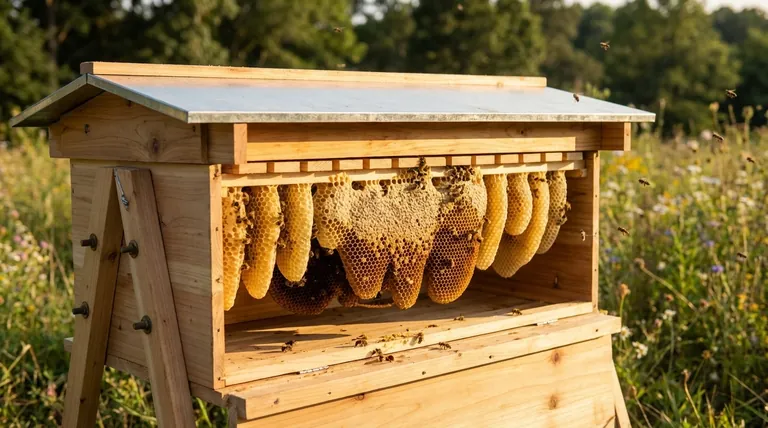The primary benefits of foundationless frames are that they allow for natural honeycomb construction, simplify the production of comb honey, and offer a more sustainable, bee-centric approach to beekeeping. This method empowers bees to build comb according to their own instincts, creating cell sizes and structures that they determine are best for the colony.
Opting for foundationless frames is a choice to prioritize the bees' natural behavior over the beekeeper's convenience. While this approach yields exceptionally natural comb and is ideal for comb honey, it demands greater care from the beekeeper, especially during honey extraction.

Aligning with the Bees' Natural Instincts
Adopting foundationless frames is fundamentally about working with the natural tendencies of a honeybee colony, rather than imposing a rigid structure upon it.
Encouraging Natural Festooning
Bees naturally link themselves together in chains or curtains, a behavior known as festooning, to build new comb. A full sheet of wax foundation can act as a barrier, forcing the bees to form two separate festoons on either side.
Foundationless frames allow a single, unified festoon to form, enabling the bees to build their comb more efficiently and with less energy expenditure.
Promoting Healthier Comb Structure
Without a pre-stamped foundation, bees are free to construct cells of varying sizes as they see fit. This flexibility allows them to build comb that perfectly suits their needs for raising brood, storing pollen, and curing honey, potentially leading to a healthier overall comb structure.
Practical Advantages for the Beekeeper
Beyond the benefits to the bees, foundationless frames offer tangible advantages for certain beekeeping goals.
Ideal for Comb Honey Production
This is the most celebrated benefit. Because there is no central plastic or wax sheet, a beekeeper can easily cut a clean, neat section of pure honeycomb directly from the frame. This makes foundationless frames the superior choice for anyone wanting to sell or harvest comb honey.
Simplicity and Accessibility
Foundationless frames are straightforward to prepare and are suitable for beekeepers at any experience level. They can be set up with a simple starter strip—such as a 1-inch piece of wax foundation or even a wooden popsicle stick—to guide the bees in building straight.
Understanding the Trade-offs and Considerations
The natural freedom of foundationless frames comes with responsibilities and potential challenges that every beekeeper must understand.
The Challenge of Honey Extraction
Extracting liquid honey from foundationless frames is possible but requires significant care. The comb lacks the central support of a foundation sheet, making it much more fragile.
When using a centrifugal extractor, you must start very slowly to allow some honey to be removed, lightening the frame before increasing the speed. An alternative, especially for small-scale beekeepers, is the crush and strain method, which involves crushing the comb and letting the honey drain through a filter. This method also yields a valuable beeswax harvest.
The Risk of Cross-Comb
The primary purpose of foundation is to ensure bees build straight, even combs. Without it, bees may build "cross-comb," connecting their wax across multiple frames. This makes hive inspections extremely difficult and risks damaging the comb and harming bees when frames are removed. Using starter strips and ensuring the hive is perfectly level helps mitigate this risk.
The Need for Structural Support
For beekeepers who intend to use a centrifugal extractor, wiring the frames is essential. The wires provide crucial internal support, helping to prevent the delicate, foundationless comb from blowing apart during the spinning process.
Making the Right Choice for Your Goal
The decision between foundation and foundationless frames depends entirely on your beekeeping philosophy and what you want to achieve.
- If your primary focus is natural beekeeping or comb honey: Foundationless frames are the ideal choice, as they align perfectly with these goals.
- If your primary focus is high-volume liquid honey extraction: Traditional frames with foundation provide the stability needed for efficient, high-speed extraction.
- If you are a new beekeeper prioritizing easy hive management: Starting with foundation can help guarantee straight combs, which simplifies inspections and builds confidence.
Ultimately, choosing foundationless frames is a decision to trust your bees' instincts to build their own perfect home.
Summary Table:
| Benefit | Key Takeaway |
|---|---|
| Natural Comb Construction | Allows bees to build comb according to their instincts, promoting natural behaviors like festooning. |
| Ideal for Comb Honey | Simplifies the production of pure, cut-comb honey, as there is no central foundation sheet. |
| Sustainability | Offers a more bee-centric, chemical-free approach to hive management. |
| Considerations | Requires careful handling for honey extraction and management to prevent cross-comb. |
Ready to embrace natural beekeeping with foundationless frames?
HONESTBEE supplies the high-quality beekeeping supplies and equipment that commercial apiaries and distributors need to succeed. Whether you're a large-scale operation exploring foundationless methods for comb honey production or a distributor stocking up for your customers, we provide the reliable, wholesale-focused support you require.
Contact HONESTBEE today to discuss your specific needs and discover how our products can help you achieve your beekeeping goals.
Visual Guide

Related Products
- Long Langstroth Style Horizontal Top Bar Hive for Wholesale
- Wooden Bee Hive Frames for Beekeeping and Wholesale
- Copper Bee Frame Eyelets for Beekeeping
- Professional Drop-Style Hive Handles for Beekeeping
- Automatic Honey Flow Beehive 4 Frame Mini Hive for Beekeeping
People Also Ask
- What are the most popular types of hives besides the Langstroth? Top Bar & Horizontal Hives Explained
- What are the advantages of a top bar hive? Simpler, Bee-Centric Beekeeping for All
- What are the box management requirements for a top bar hive vs. Langstroth? Choose Your Hive Strategy
- How are entrances designed in top bar hives? Master Beehive Layout for Maximum Honey
- What is a top bar bee hive? A Natural, Low-Stress Beekeeping Solution



















